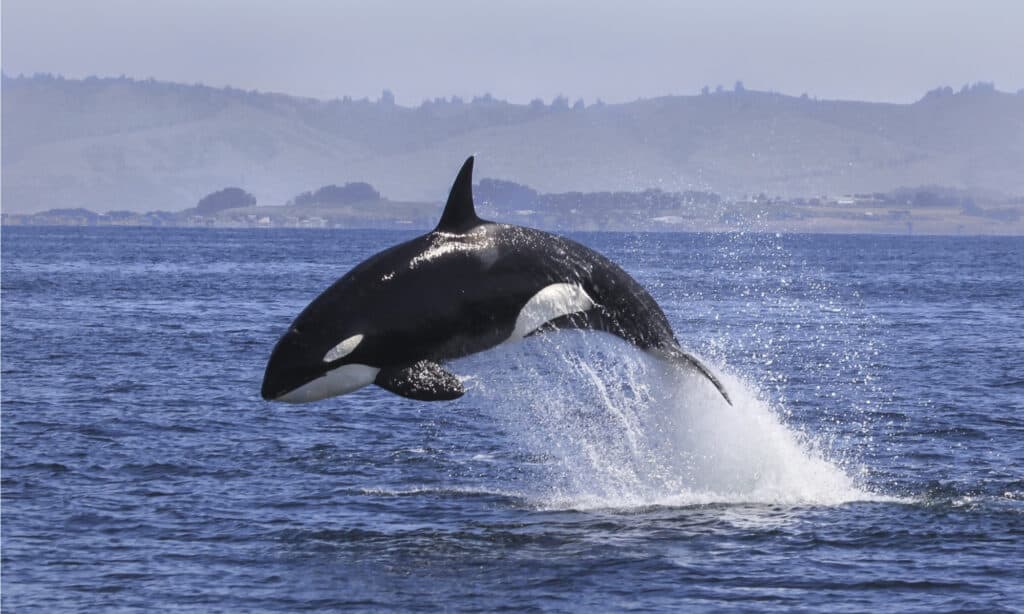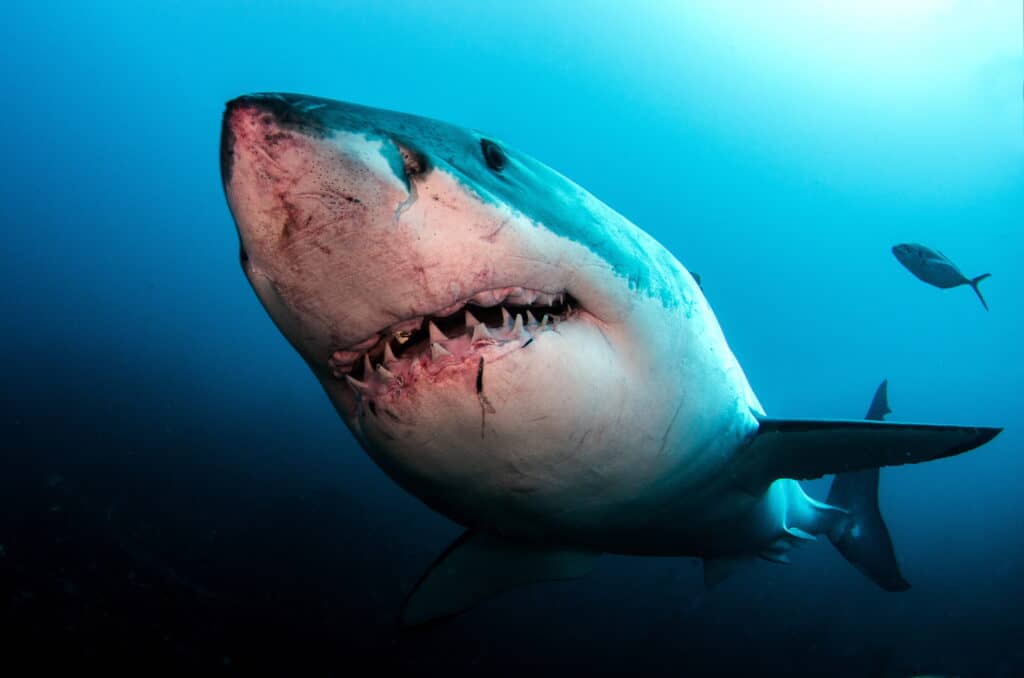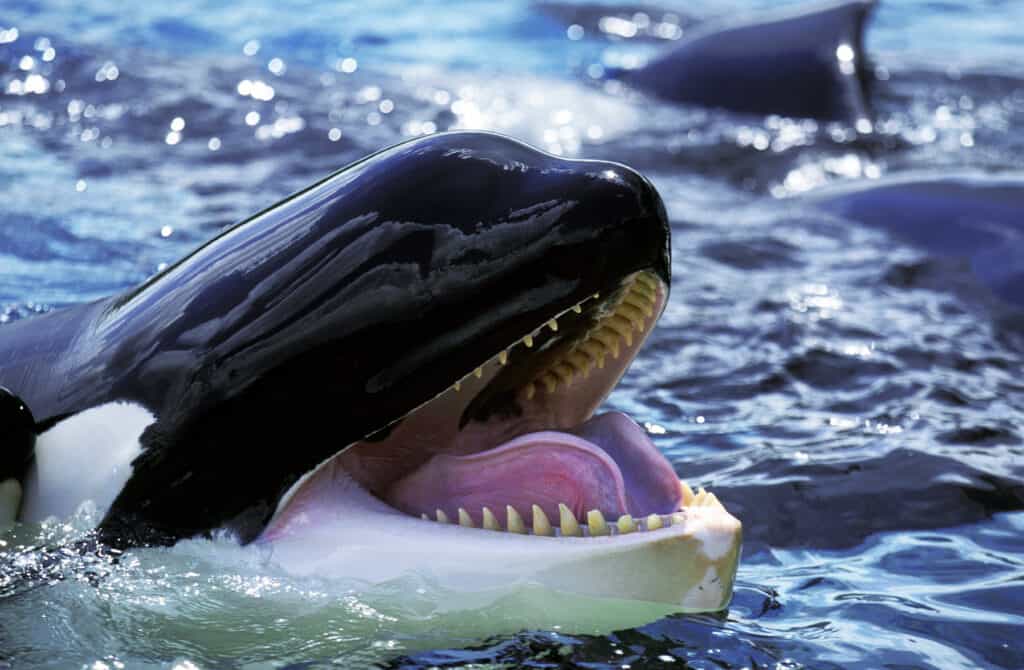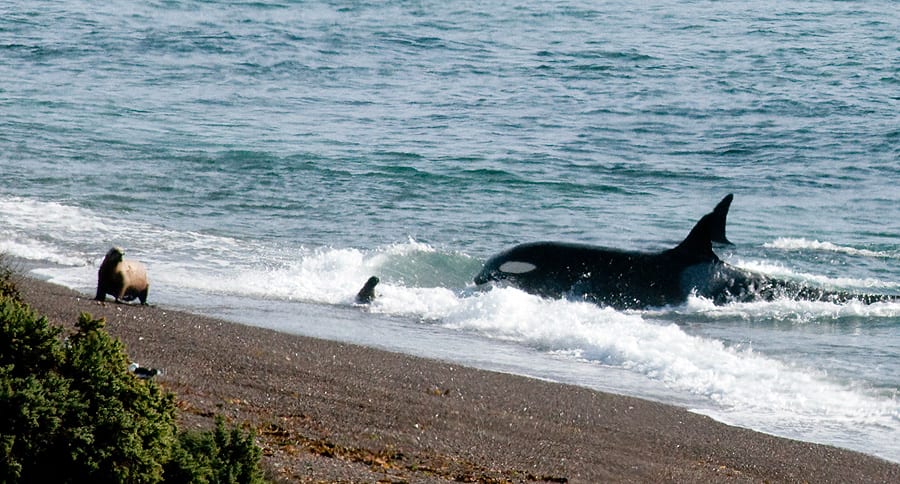Killer whales are incredibly large mammals that live up to that name from time to time. They’re powerful and smart, and they can take down other dreaded creatures in the ocean’s depths. Among the animals that orcas kill are great white sharks. These sharks are powerful in their own right, but they’re not strong enough to take on an orca. Yet, what if there was a fight between the largest great white ever vs a killer whale?
Would the large and deadly great white named Deep Blue have what it takes to kill a single killer whale in a one-on-one fight? We will explore this fight and show you what would happen.
Comparing the Largest Great White Ever and a Killer Whale

| Largest Great White Ever | Killer Whale | |
|---|---|---|
| Size | Weight: 5,000 pounds Length: roughly 21 feet long | Weight: between 6,000 and 15,000 pounds Length: from 16 up to 26 feet long |
| Speed | – Top speed mph of between 20 and 35 mph | – Top speed of 30 mph – Cruising speed of between 8 and 10 mph |
| Defenses | – Has a large cartilaginous body – Has a high swim speed and denticles that help them swim quietly – Can blend in moderately well with its surroundings | – Large, blubbery body can take a lot of damage before a fatal injury – Has between 3 and 4 inches of blubber on its body – High swimming speed helps orcas escape trouble – Often stays in groups, but not in this case |
| Offensive Capabilities | – Possess several rows of serrated teeth – Have 50 teeth in the first row of teeth alone – Teeth measure between 2 and 3 inches in length – Can deliver a 4,000 PSI bite | – Has an incredibly high biting power of 19,000 PSI – Has teeth measuring up to 4 inches long – Can use its tail to slam into others – The orca is very intelligent and can problem-solve in a fight |
| Predatory Behavior | – Vicious ambush predator that strikes from where prey can’t see them – Somewhat of an opportunist | – Can hunt, outsmart, and outlast prey – May ambush prey to an extent |
What Are the Key Differences Between the Largest Great White Ever and a Killer Whale?
The greatest differences between the largest great white ever and a killer whale include their size, strength, and the number of animals that live together. The largest great white shark ever is a female named Deep Blue that weighs about 5,000 pounds and measures 21 feet long, far less than the average killer whale that can reach sizes of 26 feet long and 16,000 pounds.
While great white sharks tend to be loners or hunt in pairs, killer whales live in pods that can include as many as 10 to 20 individuals. Lastly, killer whales have a bite force almost five times that of a great white shark, and they can kill large fish with a lash of their tail.
These differences will define the fight. The largest great white ever would need to use every bit of its power and cunning to stand a chance.
What Are the Key Factors in a Fight Between the Largest Great White Ever and a Killer Whale?
The most crucial factors to consider in a fight between the largest great white and a killer whale are size, speed, and offensive capabilities. To completely understand these creatures and get a more accurate appraisal of the fight, we need to look at more data, though.
In this case, we’re also considering how they hunt and the defenses they possess. We will break down these factors and see which creature has the advantage over the other in each group.
Largest Great White Ever vs. Killer Whale: Size

Killer whales are larger than great white sharks.
©Tory Kallman/Shutterstock.com
A killer whale is larger than the largest great white shark ever. Scientists estimate that Deep Blue weighs about 5,000 pounds, less than the low-end of the average killer whale weight of 6,000 pounds. Meanwhile, killer whales can weigh as much as 15,000 pounds, three times as much as Deep Blue.
The largest great white ever is about 21 feet long, but killer whales can measure from 16 to 26 feet.
Killer whales have the size advantage.
Largest Great White Ever vs. Killer Whale: Speed
Although it’s easy to think of large creatures as being very slow, the largest great white shark and the killer whale swim at nearly the same speed. The killer whale can hit a top speed of 30 mph, but it can cruise through the water at nearly 10 mph the rest of the time.
Great white sharks can move at speeds between 20 and 35 mph.
The great white shark has a higher burst of speed, but the two animals aren’t that far apart in terms of swim speed.
Largest Great White Ever vs. Killer Whale: Defenses
The killer whale has better defenses than the great white shark. An orca has a great sense of hearing that allows them to find prey and avoid predators. Moreover, they have large, thick bodies that feature a layer of blubber between 3 and 4 inches thick. Any predator would have to do some very severe damage to land a fatal blow.
In most circumstances, killer whales live with other members of their species. Few predators in the ocean would be so bold as to attack a pod of killer whales. Even if they did, they would have a hard time keeping up with them or doing enough damage to kill them without being killed in the process.
The largest great white shark doesn’t have the benefit of other group members. Instead, this creature uses its keen hunting senses to find prey. Great white sharks are fast, too large for many creatures to attack, and can blend into their environment rather well. Moreover, they have denticles on their skin that help them swim quieter than other creatures their size.
A killer whale has defensive advantages over a great white.
Largest Great White Ever vs. Killer Whale: Offensive Capabilities
The largest great white shark ever has the potential to be an offensive powerhouse. Great whites have rows of serrated teeth meant to shear flesh from their prey. Moreover, they bite with a force of 4,000 PSI, strong enough to clamp down and tear through all sorts of sea creatures. Combined with their powerful hunting senses, great white sharks can find and kill prey with ease.
Killer whales have a bite force that measures almost five times that of a great white shark. They bite with a force of 19,000 PSI, driving teeth measuring up to 4 inches long into their prey. It’s not just their mouth that other creatures need to worry about, though. An orca can easily swat another animal with its tail and kill it.
The killer whale has an offensive advantage.
Largest Great White Ever vs. Killer Whale: Predatory Behavior

Individually, the great white shark is a better predator than the killer whale.
©Tomas Kotouc/Shutterstock.com
The great white shark has amazing predatory senses that helps it find prey based on smell, taste, hearing, and even electromagnetism. They use these senses to find prey and then ambush it with a burst of speed and a series of ruthless bites.
Killer whales are not ambush predators in the same way as great white sharks. However, they can gather large schools of fish with other orcas and eat them, knock prey into the water, and use their intelligence to overcome obstacles in obtaining food.
The great white shark is the better individual predator.
Who Would Win in a Fight Between the Largest Great White Ever and a Killer Whale?

The killer whale would win the battle against the largest great white ever.
©slowmotiongli/Shutterstock.com
A killer whale would win a fight against the largest great white ever. The only case in which an orca could potentially be killed by a great white is if the largest great white took on the smallest orca, and even then, it would be at a bit of a size disadvantage.
The great white could potentially attack the orca first, landing a damaging blow. Perhaps if Deep Blue shredded an orca’s fins or managed to tear into a vital area, it could win the fight. The more likely scenario is that the killer whale would start the fight because it is larger and stronger.
In fact, recent video footage has shown killer whales killing great white sharks for the first time. Even though the killer whale would need to be careful against the deadly foe, it can attack with its powerful bites and use its tail to bat around the shark.
The fight would be bloody and long, but the whale’s larger body would be able to take more damage than the shark’s before giving out. All told, even the biggest great white is completely outclassed in this battle.
Do Great White Sharks Avoid Killer Whales?

Killer whales are considered the top apex predators that have no natural predators and are fierce in their pursuit of prey.
©Ecohotel, CC BY-SA 3.0 – License
Great white sharks have been known to flee an area when they know there are killer whales in the vicinity. As a result of being tagged by researchers, these sharks’ behaviors can be monitored, especially in areas like South Africa, where orcas have exhibited their inclination to attack sharks. Orcas are highly intelligent mammals and they have been observed flipping sharks on their backs to induce a paralytic state called tonic immobility. By keeping them in this paralytic state, they are able to eat the parts they prize.
Killer whales have demonstrated that they hunt great white sharks in order to kill them to consume their highly prized fatty-rich livers. There are numerous accounts in South Africa of killer whales working together to round up great whites and these sharks are actually afraid of this apex mammal. Carcasses of great white sharks, on the Western Cape of South Africa, have been found with their livers missing. There is even video footage of a great white trying to evade a group of orcas.
The infamous killer whale duo, known as Port and Starboard, have been preying on white sharks for quite some time, although they are not the first ones to do so they are the most renowned, having killed around 17 sharks in one day. There are earlier accounts of two orcas, dating back to 1997, who were eating the fatty-rich liver of a great white. This event was witnessed by tourists who were whale watching around the Farallon Islands, located off the coast of San Fransisco.
The photo featured at the top of this post is ©
Thank you for reading! Have some feedback for us? Contact the AZ Animals editorial team.







